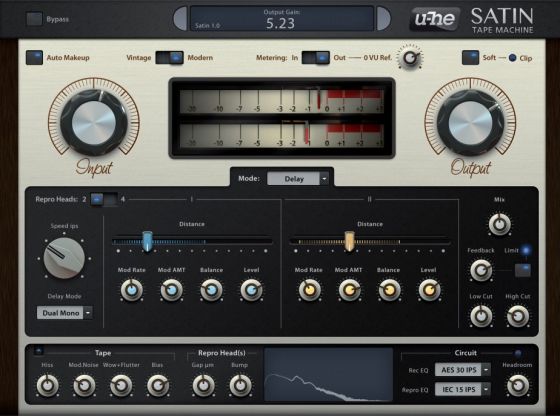u-he Satin v1.3.2.12092 VST2 VST3 AAX [WIN]
Nothing else quite sounds like tape. Satin puts the legacy of tape recording in your hands: from top-of-the-line multi-track consoles to humble cassette decks. All the good (saturation, transient smoothing, compression) as well as the bad (noise modulation, flutter, hiss) qualities are under your control. Construct your (im)perfect tape machine.
Satin in the spotlight…
- Lush analogue tape sound
- Includes historical developments in tape technology
- Control up to 8 instances of Satin at once using the Group panel
- 5 popular noise reduction encoder / decoder models
- Service panel: Controls for hiss, wow and flutter, bias, head gap, azimuth, saturation, high frequency compression and more
- Modern or vintage tape material
- Internal sample rate up to 384kHz
- 5 circuit models for recording and reproduction EQs
- Stereo delay mode (2 or 4 heads) with multiple-mono, cross or ping-pong routing
- Tape flange mode with classic through-zero flanging
- Adjustable tape speed from 1.87 to 30ips
- Pre-emphasis and soft clipping options
- Preset browser with search functions
- NKS FX compatible
- Resizable UI from 70% to 200%
- Skinnable UI
- 120+ factory presets
Once reserved for major studios, digital recording has become widespread. It offers pristine sound and comfortable editing at a fraction of the cost of multitrack tape. Despite all the advantages, however, digital audio can easily sound too clean and impersonal. So musicians, producers and audio engineers have turned to traditional analogue tools to bring some life back into overly clinical recordings. A world of non-linear behaviours, distortion, saturation and much more arises during tape recording and playback. Bringing these coveted characteristics of magnetic tape into the digital realm, in unprecedented quality—this is what Satin is all about.
Features
The sound
That tape sound depends on interaction between the various parts of a tape machine. Each contributes in one way or another—enhancing, reducing, combining—to generate the final sound.
Satin models individual components and lets them interact in the same way. For maximum flexibility in sound shaping, Satin is a toolkit of alternative parts, not an emulation of a single machine. Build your own custom tape unit. The perfect final sheen for your mixdown, or “glue” multiple drum tracks together, decode old NR-encoded cassette tape, or misuse Satin for extreme effects.
Delay and flange
After developing the components for a tape machine toolkit, our minds turned other popular tape-based machines. Delay and flange immediately jumped to mind.
In service
Imagine opening up a tape machine, peeking “under the hood” and tinkering with the parts. That is what service technicians used to do, and it is what the Service Panel in Satin is for. It gives you detailed control over some of the more esoteric and characterful elements.
In the Tape section are perhaps the more readily identifiable attributes of tape recording: hiss, asperity, wow & flutter, crosstalk and bias. Dial in a little of each for a retro vibe or “glue”. Dial in the extreme settings and you can end up with the sound of poor quality tape left in someone’s basement far too long.
The Repro Head(s) parameters control the physical attributes of the tape heads. With Gap Width and Bump you can cut or boost certain frequencies and introduce resonances and fluctuations. Azimuth pushes the audio off-centre for interesting spatial effects, mimicking a skewed tape head.
Finally the Circuit section lets you change the inner EQ circuitry. Included are various industry standard EQ curves, should you want to mimic specific machines. But Satin goes a step further by allowing independent selection of the recording and reproduction EQ curves. Which you can abuse for weird processing effects, or to correct EQ errors in old recordings (see below).
Decoding
Selectable Compander and Circuit settings make Satin useful as a format converter.
If you have a tape recording with an unsuitable EQ, using Circuit’s independent RecEQ and ReproEQ selectors you can set a new target EQ curve and make changes. Similarly, Compander can handle audio recorded with specific noise reduction (NR) encodings. Just run it through Satin with Decoder set to match the known NR encoding type.
Requirements
Host software / DAW
1GB RAM, more recommended
50MB free disk space
1000 × 600 or larger display
Modern CPU required:
Windows/Linux: Intel Nehalem or newer, AMD Bulldozer or newer
Formats
Satin is not a standalone product, it requires host software. Satin is compatible with nearly all DAWs.
Windows:
VST2, VST3, AAX*
32-/64-bit
- Share on Facebook




